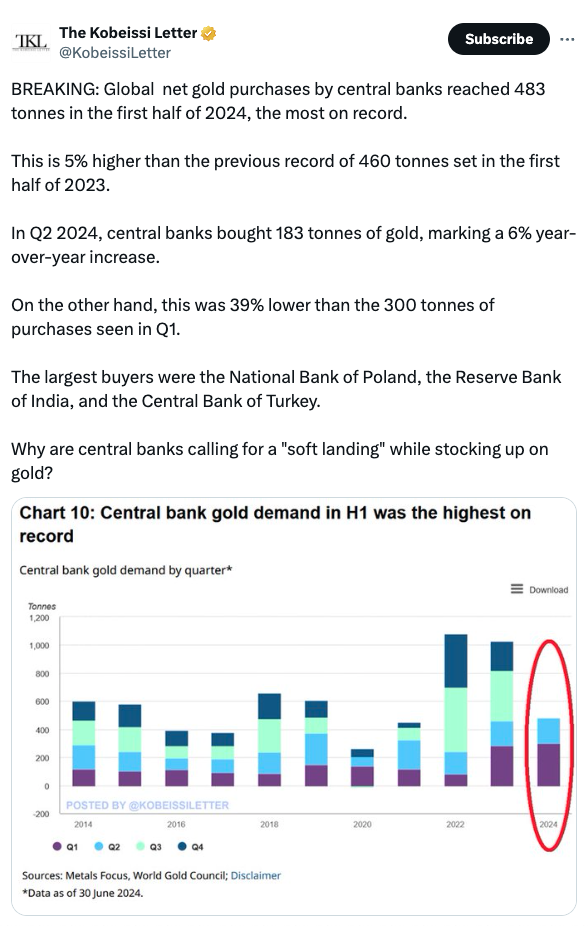
In 2024, central banks globally have accelerated their acquisition of gold, reaching unprecedented levels, signaling a significant shift towards store of value assets amid broader financial market dynamics.
According to a report by The Kobeissi Letter on September 2, central banks around the world have purchased a record 483 tonnes of gold in the first half of 2024. This purchase volume surpasses the previous record of 460 tonnes set in the first half of 2023 by 5%. The second quarter of 2024 alone saw central banks adding 183 tonnes, a 6% increase from the same period last year.

Major buyers included the National Bank of Poland, the Reserve Bank of India, and the Central Bank of Turkey. Adam Glapinski, President of the National Bank of Poland, indicated that the country’s strategic goal is to have gold constitute 20% of its national reserves.
Geopolitical Shifts and the Turn to Gold
Spencer Hakimian, founder of Tolou Capital Management, noted that nations such as China, India, Russia, and Saudi Arabia are moving away from Western financial assets. “Gold is the only neutral and non-volatile reserve asset,” Hakimian stated, highlighting a growing distrust in traditional Western reserve assets.
Tech entrepreneur Kim Dotcom suggested that the introduction of a gold-backed stablecoin by BRICS nations could further amplify gold demand and destabilize the dollar. He predicted a significant economic shift away from the U.S. by 2030 due to these developments.
Despite the impressive performance of gold, which has risen 23% year-to-date, outpacing the S&P 500’s 18% gain, Bitcoin has seen even higher growth. Bitcoin’s value increased by 37% in 2024, despite a significant drop from its March peak. This growth occurred amid discussions around spot BTC exchange-traded funds in the United States.
Peter Schiff, a well-known critic of cryptocurrencies, acknowledged that while Bitcoin had substantial early gains in 2024, it had since retracted. Nonetheless, gold reached an all-time high of $2,525 per ounce on August 27, fueled by robust demand.
Central Banks and Cryptocurrency Caution
Despite Bitcoin’s strong performance, central banks remain cautious about integrating cryptocurrencies into their reserve strategies. This hesitation reflects ongoing uncertainties about the stability and long-term viability of cryptocurrencies as reserve assets.
The trend of central banks massively accumulating gold underscores a strategic pivot to more stable store of value assets amidst global financial uncertainties. While gold continues to play a traditional role in national reserves, cryptocurrencies, despite their recent gains, are viewed with caution. The evolving landscape of global finance suggests that both assets will remain integral to discussions about reserve strategies and economic stability.
Featured image credit: Scottsdale Mint via Unsplash
Follow us for more breaking news on DMR
